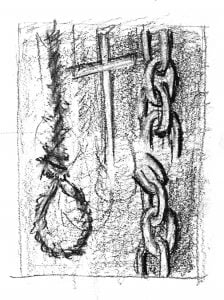A Thumbnail Early Life of Frederick Douglass
Frederick Douglass was born a slave named Frederick Augustus Washington Bailey in Talbot County, Maryland, probably in February 1818. He was separated from his mother at an early age. She was rented out to work on a farm several miles away while he was raised by a woman he knew as grandmother in a shack on the plantation where he was born. His mother had to walk all night to visit him and then return to begin work at dawn. She as able see him only a few times before her death.
Young Frederick’s first master, and perhaps his father, was one Captain Anthony, the successful and cruel clerk of a Colonel Lloyd, owner of several plantations in the area. He often had to witness bloody whippings of older slaves who had irritated the master.
At age 7 or 8 he was shipped off to Baltimore to help care for the son of Captain Anthony’s relatives. Judging by the adult he would become, young Frederick must have been a beautiful and precocious child. Initially he won the heart of Sophia Auld, the mother of the boy he was to care for. Ignorant of the law, she began to teach him how to read, until her husband found out and forbid her to go further. Too late! The seeds of learning had already been planted in a fertile mind.
He later wrote that when he was about 12 he got hold of a copy of The Columbian Orator. Published in 1797 this book was a perennial best seller of great speeches from Socrates to Washington. It opened his mind to the real possibility of a life of freedom and learning while introducing him to what would become his career as one of the great public speakers of American history.
In the relatively relaxed atmosphere of Baltimore the teenaged Frederick was apprenticed to a shipyard where he learned the art of caulking.
At age 20, after a failed attempt to reach freedom, he became engaged to a free Black woman named Anna Murray. She made him a sailor suit; he borrowed papers from a free Black sailor; and thus provided, he was able to reach New York. Anna joined him there and they married.
The couple decided to settle in New Bedford, Massachusetts, a haven for many former slaves. Here Frederick could earn his living in the shipyard. He changed his last name to Douglass and spent his spare time reading and writing. Soon he was publishing in William Lloyd Garrison’s abolitionist newspaper, The Spectator.
He began public lecturing and wrote his first book Narrative of the life of Frederick Douglass, an American Slave. Published in 1845 the book was a best seller and led to his invitation to lecture in the British Isles, which he did for nineteen months, returning to resettle his family in Rochester, New York, an area that was uncommonly friendly to the abolitionist and women’s rights movements.
Illustration by Zoe McDonnell.

